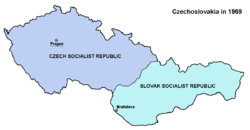- Czech Socialist Republic
-
Česká socialistická republika
Česká republika
Czech Socialist Republic
Czech RepublicFederal subject of the Czechoslovak Socialist Republic (1969—1990) and Czech and Slovak Federal Republic (1990—1993) ← 
1969–1993  →
→

Official flag in 1990—1992 Small coat of arms of the Czech Republic
from 1992Czech Socialist Republic within CSSR Capital Prague Government Socialist republic (1968—1989)
Parliamentary republic (from 1989)Legislature Czech National Council History - Constitutional Law of Federation 1 January 1969 - Velvet Revolution 17 November – 29 December 1989 - Independence 1 January 1993 From 1969 to 1990, the Czech Socialist Republic (Česká socialistická republika in Czech; abbreviated ČSR) was the official name of that part of Czechoslovakia that is the Czech Republic today. The name was used from 1 January 1969 to March 1990.
History
After the occupation of Czechoslovakia in 1968, liberalisation reforms were stopped and reverted. The only exception was the federalization of the country. The former centralist state Czechoslovakia was divided in two parts: the Czech Socialist Republic and Slovak Socialist Republic by the Constitutional Law of Federation of 28 October 1968, which went into effect on 1 January 1969. New national parliaments (the Czech National Council and the Slovak National Council) were created and the traditional parliament of Czechoslovakia was renamed the "Federal Assembly" and was divided in two chambers: the House of the people (cz:Sněmovna lidu / sk:Snemovňa ľudu) and the House of Nations (cz:Sněmovna národů / sk:Snemovňa národov). Very complicated rules of voting were put in effect.
After the fall of socialism in Czechoslovakia, the word "socialist" was dropped in the names of the two republics, i.e. the Czech Socialist Republic was renamed Czech Republic (though it was still a part of Czechoslovakia).
The complicated system of parliament voting (there were de-facto 5 different bodies each having right of veto) was kept after the fall of socialism, complicating and delaying political decisions during radical changes in economy.
Later, in 1993, the Czech Republic became an independent state (see Dissolution of Czechoslovakia).
See also
- Constitutional Law of Federation
- History of Czechoslovakia
- Slovak Socialist Republic
- Czech and Slovak Federal Republic
External links
Timeline of Czechoslovak statehood Timeline Origins
pre-1918The First Republic
1918 – 1938World War II
1938 – 19451945 – 1948 Coup d'état
1948 – 1989Velvet Revolution
1989 – 1992Dissolution
1993 –Bohemia
Moravia
& Silesiacrown lands of the Austrian Empire First
Czechoslovak Republic
(ČSR, 1918 – 1938)
Full boundaries and government established by the 1920 constitutionSudetenland
annexed by Nazi Germany
(1938 – 1945)Third
Czechoslovak Republic
(ČSR, 1945 – 1948)Czechoslovak Republic
(ČSR, 1948 – 1960)
Declared a people's democracy (without a formal name change) under the Ninth-of-May Constitution following the 1948 coupCzechoslovak Socialist Republic
(ČSSR, 1960 – 1989)Czech and Slovak Federal Republic
(ČSFR, 1990 – 1992)Czech Republic
Czechia
(since 1993)Second
Czechoslovak Republic
(ČSR, 1938 – 1939)
Including the autonomous regions of Slovakia and Carpathian RutheniaProtectorate of Bohemia and Moravia
(1939 – 1945)After the Prague Spring, consisted of:
Czech Socialist Republic
(ČSR, 1969 – 1992)
Slovak Socialist Republic
(SSR, 1969 – 1992)
Socialist dropped from names in 1990Slovakia territory of the
Kingdom of HungarySlovak Republic
(1939 – 1945)Slovak Republic
Slovakia
(since 1993)Southern Slovakia and Carpatho-Ukraine
Annexed by: Hungary
(1939 – 1945)Carpathian Ruthenia Zakarpattia Oblast of the Ukrainian SSR
(1944/1946 – 1991)Zakarpattia Oblast of Ukraine
(since 1991)see: Austria-Hungary Czechoslovak government-in-exile Categories:- Communist Czechoslovakia
Wikimedia Foundation. 2010.

